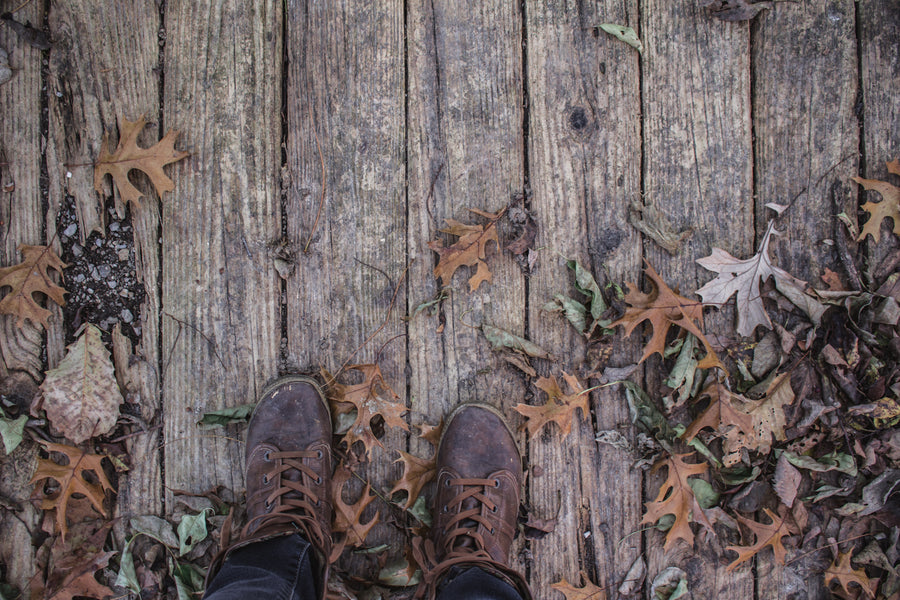How to Look After Decking In Winter
Posted by Greg Parkins on
The wintery season is in full swing, but it doesn’t mean you can’t use your decking or keep it looking in great shape until Spring comes back around next year.
With the right care and protective measures in place, you can keep your deck looking great for the months ahead, improving the overall lifespan of your outdoor space without too much trouble.
Check out our top tips to find out how you can take care of decking surfaces in the winter, making sure it’s maintained year after year.
Keep your decking clean
Keeping your decking nice and clean throughout the winter is key to maintaining your outside space. You’ll be surprised at the amount of dirt that accumulates due to bad weather, fallen leaves, and general dirt from the garden.

So, how do you clean your decking in winter?
Make sure to sweep your outside area using a stiff wire brush to remove any leaves, dirt or material that may have found its way onto your decking. A build-up of wet leaves can cause staining and potentially rotten wood.
If needed, apply a multi-purpose cleaning solution or some soapy water to your deck, washing it down with a garden hose. Although this requires some time and a bit of elbow grease, it is the easiest method to get your decking back to its best.
When using a multi-purpose cleaning solution, make sure to read the instructions on the label, as some products might not be healthy for any nearby plants in your garden.
A pressure washer is another great alternative to help remove any stubborn dirt that doesn’t budge with a general wire brush. If you choose to use a pressure washer, check the nozzle to make sure the water pressure is spread evenly, as it may damage the wood if the pressure is too concentrated.
Use a treatment or repellent
Now that your outside area is sparkling clean, it’s time to winterize your deck for the cold months that lay ahead.
A deck protector should be applied once a year, to maintain the condition of your deck and avoid any issues throughout the cold winter months.
Decking protector solutions can protect your decking from the natural elements, such as discolouration from sun damage or wood rot from rainwater.
The solution will keep the wood healthy, preventing any warping or bowing.

Decking finish can be used for protection, giving you a range of colour options from subtle shades to bolder tones that will revitalise your outdoor space, bringing your deck to life in the winter sun. The paint will also fill in any small cracks and prevent wood splinters from appearing.
Your decking can also be refreshed with decking oil or stain. Decking oils enhance the natural appearance of the wood, soaking in to protect against cracking, splitting or warping.
Stains can add a fresh look to the wood with a variety of options, changing the natural colour and appearance.
Many people ask, can you paint decking in winter? Well, before applying any of the above, it is recommended to wait until a mild or dry day as the products won’t apply properly if done in wet conditions.
For more information on whether you need decking oil or stain, read our blog post here.
Alternatively, using a protective sheet to shield your deck from the winter weather will also help. Don’t forget to remove the cover on sunny days to help the wood breathe and avoid any build-up of condensation.
Make sure your decking is safe
Throughout the colder months, it’s important to ensure that your outdoor decking remains a safe place to use after the impact of winter weather.
Ice, snow or rainwater can make the wood a hazardous spot to walk across. But how do you stop decking being slippery?
If you’re still having trouble with a slippery surface, use non-slip decking strips to improve the traction on the surface of your outside area.
Shovelling or sweeping away the snow can help avoid ice setting on your decking and becoming slippery when wet.
Another option is to sprinkle sand over your outdoor decking after snow has fallen. The sand will provide more traction on the surface, which will make your decking easier to walk across.
Stay away from using rock salts to de-ice your decking. Although rock salts are cheap and readily available, they will dry out the moisture and deteriorate the wood.
If your deck has been water-sealed, applying a mild de-icing salt will help tackle snowfall through the winter. Always make sure to check the product label, as some products may be harmful to pets.

Restore your decking
If your decking is looking a little worse for wear this winter, it may be time to consider a bit of a restoration project.
First things first, identify the root of any issues and check your decking for any signs of damage.
If needed, replace any loose or broken nails with brand new ones. If the wood is soft, you may need to think about replacing those decking boards in order to improve the structural integrity of the decking.
Check the railings and the rest of the decking for signs of damage, rot, or mould. Identifying any problems will make the restoration process much easier, avoiding any long term issues.
If the wood itself has already discoloured or turned grey, consider using a wood restorer. This will help rebuild some of the natural oils the wood may have lost over the years and add some well needed protection from the unpredictable British weather.

By following the advice outlined above, your outdoor decking should last for years to come, allowing you to enjoy your outside space no matter what the season!
For more inspiration on how to get the most out of your decking area in the winter, discover our top tips here.

